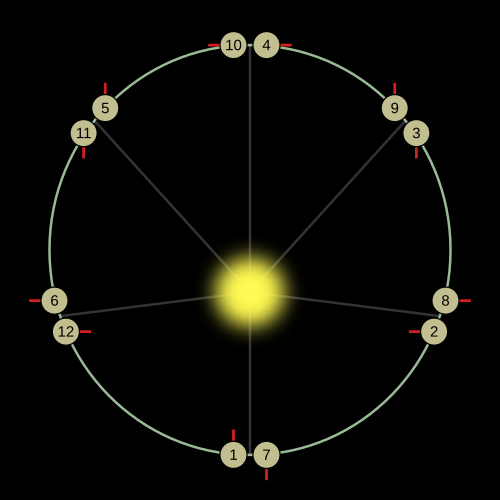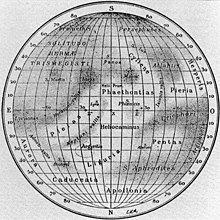Comments and questions about the
APOD on the main view screen.
-
Chris Peterson
- Abominable Snowman
- Posts: 18198
- Joined: Wed Jan 31, 2007 11:13 pm
- Location: Guffey, Colorado, USA
-
Contact:
Post
by Chris Peterson » Sat Oct 08, 2011 11:44 pm
saturn2 wrote:I think that one solar day on Mercury is of 58 Earth days.
But the astronomers says it have a new concept of solar day on Mercury.
It¨s new for me. I don´t understand.
A sidereal day is the actual period of rotation, which can be measured against the stars- the time it takes the planet to rotate through 360°. A solar day is the period between one solar transit (noon) and the next. On Mercury, a sidereal day is 58.7 Earth days. A solar day is 176 Earth days. The latter is much longer because as the planet is rotating, it is also orbiting the Sun. In order to turn enough to bring the Sun back to the meridian, it has rotated much more than 360°, and therefore taken longer than a sidereal day.
The exact same thing happens here on Earth, but the difference is much smaller- because we rotate faster and orbit slower.
-
elipongo
- Asternaut
- Posts: 5
- Joined: Sun Feb 07, 2010 10:54 pm
- AKA: Elias Friedman
- Location: New York City
Post
by elipongo » Sun Oct 09, 2011 1:45 am
The link from the word "meridian" leads to Wikipedia's article on the Hun Kal crater. The article states that the crater is the reference point for Mercury's longitude coordinate system, but that it was defined as 20 degrees West because the "actual" Prime Meridian was in shadow at the time of Mariner 10's visit. Since selecting a prime meridian is an arbitrary exercise, I assume that it was based on some telescopically observed landmark predating Mariner 10 and was retained to preserve compatibility with older observations. Does anyone know what that original landmark was?
-
neufer
- Vacationer at Tralfamadore
- Posts: 18805
- Joined: Mon Jan 21, 2008 1:57 pm
- Location: Alexandria, Virginia
Post
by neufer » Sun Oct 09, 2011 2:43 am
elipongo wrote:
The link from the word "meridian" leads to Wikipedia's article on the Hun Kal crater. The article states that the crater is the reference point for Mercury's longitude coordinate system, but that it was defined as 20 degrees West because the "actual" Prime Meridian was in shadow at the time of Mariner 10's visit. Since selecting a prime meridian is an arbitrary exercise, I assume that it was based on some telescopically observed landmark predating Mariner 10 and was retained to preserve compatibility with older observations. Does anyone know what that original landmark was?
Back when they thought that just one side of Mercury was visible
prime meridian was defined simply as the subsolar meridian.
http://en.wikipedia.org/wiki/List_of_albedo_features_on_Mercury wrote:
<<Early telescopic observations of Mercury were based on the assumption that Mercury keeps one of its faces permanently turned toward the Sun, through the mechanism of tidal locking. Although this is not true (Mercury rotates three times on its axis for every two revolutions around the Sun), when it is positioned for best viewing from Earth, the amount by which its visible face has rotated from its previous best viewing position is fairly small.
A map of Mercury made in the 1910s by astronomer Eugène Michel Antoniadi shows the following albedo features, localized by a grid in which 0° longitude is the (assumed) subsolar meridian. No certain connection has been made between these features and the topographic features viewed on Mercury by the Mariner 10 spacecraft. Mariner 10, however, imaged less than half of Mercury's surface.>>
I'm
guessing that later one of the two alternate subsolar meridians
at
Mercury perihelion was chosen as prime meridian back
when radar mapping was done (prior to Mariner 10).
The Hun Kal crater was then used simply to refine this predetermined scheme.
Art Neuendorffer
-
G-Lode
Post
by G-Lode » Tue Oct 11, 2011 8:12 pm
Yes it does seem a little odd that the most anomalous feature in the mono-chrome image is not imaged in the higher resolution color photo. I see a pyramidal object that would have to be absolutely freaking huge. The shadow has a slightly stepped edge at high magnification...conspiracy theories anyone?
-
djones
Post
by djones » Mon Oct 24, 2011 2:33 pm
Decades ago Isaac Asimov wrote an article about Mercury that stated that because of the elliptical nature of Mercury’s orbit and the slow progress of the sun through its sky, there would be times where the sun appeared to go retrograde. He noted that at certain places on the surface, each day would have two sunrises and two sunsets. At sunrise it peeks over the horizon and then goes back down to be followed by a second sunrise. That evening, it would set, reemerge and then set again. Was Isaac using old data or is this still true?
-
Chris Peterson
- Abominable Snowman
- Posts: 18198
- Joined: Wed Jan 31, 2007 11:13 pm
- Location: Guffey, Colorado, USA
-
Contact:
Post
by Chris Peterson » Mon Oct 24, 2011 2:59 pm
djones wrote:Decades ago Isaac Asimov wrote an article about Mercury that stated that because of the elliptical nature of Mercury’s orbit and the slow progress of the sun through its sky, there would be times where the sun appeared to go retrograde. He noted that at certain places on the surface, each day would have two sunrises and two sunsets. At sunrise it peeks over the horizon and then goes back down to be followed by a second sunrise. That evening, it would set, reemerge and then set again. Was Isaac using old data or is this still true?
This is generally true (it depends where you are on the surface), and is a consequence of Mercury's 3:2 spin-orbit resonance, which has been recognized since the mid-1960s.
-
neufer
- Vacationer at Tralfamadore
- Posts: 18805
- Joined: Mon Jan 21, 2008 1:57 pm
- Location: Alexandria, Virginia
Post
by neufer » Mon Oct 24, 2011 3:19 pm

If the red pole represents the 12 o'clock position/meridian then
the folks living near the 3 o'clock & 9 o'clock position/meridians
will observe oscillating sunset/rises at perihelion.
djones wrote:
Decades ago Isaac Asimov wrote an article about Mercury that stated that because of the elliptical nature of Mercury’s orbit and the slow progress of the sun through its sky, there would be times where the sun appeared to go retrograde. He noted that at certain places on the surface, each day would have two sunrises and two sunsets. At sunrise it peeks over the horizon and then goes back down to be followed by a second sunrise. That evening, it would set, reemerge and then set again. Was Isaac using old data or is this still true?
That has been known to be true since 1965.
At perihelion Mercury revolves around the sun
at a somewhat higher RPM than it rotates on its axis.
Art Neuendorffer
-
neufer
- Vacationer at Tralfamadore
- Posts: 18805
- Joined: Mon Jan 21, 2008 1:57 pm
- Location: Alexandria, Virginia
Post
by neufer » Fri Oct 28, 2011 7:31 pm
http://messenger.jhuapl.edu/gallery/sciencePhotos/image.php?gallery_id=2&image_id=681 wrote:
A Global View from Orbit
Release Date: October 28, 2011
Instrument: Narrow Angle Camera (NAC) and Wide Angle Camera (WAC) of the Mercury Dual Imaging System (MDIS)
Resolution: 2.5 km/pixel
Scale: Mercury's diameter is 4880 kilometers (3030 miles)
Map Projection: simple cylindrical
[
This image] shows a global mosaic that covers over 99.9% of Mercury's surface! This mosaic is made primarily of MDIS images acquired as part of the surface morphology base map, which during the first six months of MESSENGER's orbital mission mapped over 98.7% of the surface with nearly 22,000 images. Variations in the morphological appearance of the surface are due to differences in the Sun illumination conditions and viewing geometries for the different images taken over those six months. In this mosaic, small gaps in the surface morphology base map have been filled by images taken as part of the color base map imaging campaign. A few remaining gaps have been filled by data obtained by a combination of Mariner 10 and MESSENGER flybys, most of which is visible near the north pole.>>
Art Neuendorffer

